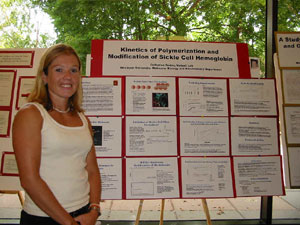
Catherine Roden
The Hemoglobin Team
|
Catherine Roden '03 Research Project: Does modification of b-93 Cys residues affect sickle cell fiber formation? |
Current studies of the effects of nitric oxide on sickle cell hemoglobin have shown that the β-93 cysteine residue plays an important role in nitric oxide binding which in turn inhibits fiber formation in sickle cell patients. In order to gain a better understanding of the interaction at the cysteine residue, my research involves chemical modifications of the β-93 cysteine residues to investigate the effect on fiber formation through solubility and turbidity experiments. It is thought that modification of β-cys-93 interferes with polymerization, increases oxygen affinity, and inhibits sickling. By quantifying the extent of fiber formation as well as the kinetics of fiber formation, more information can be gained about the importance of this particular residue in fiber formation. Modified HbA and HbS derivatives are generated through a maleimide reaction with the sulfhydryl, resulting in a relatively large and rigid succinimidyl group attached to β93. Modification of the β93 sulfhydryl has been shown to have an impact on both the allosteric properties of HbA and S and the ligand binding reactivity of HbA and S within a given quarternary state. My current research involves modifications with the following thiol reagents; iodoacetamide, N-ethyl maleimide and p-mercuribenzoate. Modification of these residues is expected to affect the polymerization rates, particularly the delay time or the time it takes for the hemoglobin to reach 50% of fiber polymerization.
